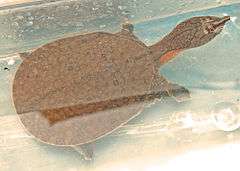Indian narrow-headed softshell turtle
| Indian narrow-headed softshell turtle | |
|---|---|
| | |
| Scientific classification | |
| Kingdom: | Animalia |
| Phylum: | Chordata |
| Class: | Sauropsida |
| Order: | Testudines |
| Suborder: | Cryptodira |
| Family: | Trionychidae |
| Genus: | Chitra |
| Species: | C. indica |
| Binomial name | |
| Chitra indica (Gray, 1831) | |
| Synonyms[1] | |
| |
Indian narrow-headed softshell turtle (Chitra indica) also known as small-headed softshell turtle[2] is an endangered species of softshell turtle found in rivers of South Asia. It is very large and feeds on fish, frogs, crustaceans and molluscs, which it ambushes.[3] In the past it was included in Chitra chitra; a species restricted to Southeast Asia using current taxonomy.[1]
Diagnostic characters
This species is very large with a carapace up to 1.1 m (3.6 ft).[3]
- Overall color: olive to deep olive-green;
- Very complex midline (vertebral) carapacial pattern;
- Midline (vertebral) carapacial stripe present;
- Complex radiating costal stripes;
- Paramedian neck stripes forming a bell-like pattern on anterior carapace absent;
- Neck stripes do not form a continuous light rim around carapace;
- No distinct pair of neck stripes;
- Dark speckling on "light" (head and neck) stripes;
- Anterior neck "V" divergence point on neck;
- 3-4 forelimb lamellae;
- No peri-orbital X pattern;
- No distinct peri-orbital ocelli;
- No distinct naso-orbital triangular "figure";
- Few, if any, black dots present on chin pattern.
Type locality: "India, fl. Ganges, Penang"; restricted by Smith (1931:162) to "Fatehgarh, Ganges," India = "India: Ganges; Futtaghur" (Gray 1864: 92)
Distribution
This species is found in the Sutlaj and Indus river basins of Pakistan, and Ganges, Godavari, Mahanadi and other rivers basins of India, Nepal and Bangladesh.[3] Although widespread, it occurs in low densities, even within protected areas.[3] It is threatened by hunting and habitat loss.[3] It prefers clear, large or medium rivers with sandy bottoms.[3] It spends most of time concealed below the sand, sometimes with only the tip of the nose exposed.[3]
References
- 1 2 Fritz Uwe; Peter Havaš (2007). "Checklist of Chelonians of the World". Vertebrate Zoology. 57 (2): 312. ISSN 1864-5755. Archived from the original (PDF) on 2010-12-17. Retrieved 29 May 2012.
- ↑ Reptiles of Dudhwa tiger reserve... dudhwatigerreserve.com
- 1 2 3 4 5 6 7 Das, I.; and Singh, S. (2009). Chitra indica. Conservation Biology of Freshwater Turtles and Tortoises, Chelonian Research Monographs 5
- Asian Turtle Trade Working Group (2000). "Chitra indica". IUCN Red List of Threatened Species. Version 2006. International Union for Conservation of Nature. Retrieved 9 May 2006. Database entry includes a brief justification of why this species is endangered and the criteria used
- Boulenger, G.A. 1889 Catalogue of the Chelonians, Rhynchocephalians, and Crocodiles in the British Museum (Natural History). British Museum, London, 311 pp.
- Engstrom, Tag N., H. Bradley Shaffer, and William P. McCord. 2002 Phylogenetic Diversity of Endangered and Critically Endangered Southeast Asian Softshell Turtles (TrionychidaChitra). Biological Conservation 104 (2):173-179
- Gray, J. E. 1831 A synopsis of the species of Class Reptilia. In: Griffith, E & E. Pidgeon: The animal kingdom arranged in conformity with its organisation by the Baron Cuvier with additional descriptions of all the species hither named, and of many before noticed [Vol. 9]. Whittaker, Treacher and Co., London: 481 + 110 pp.
- Gray, J. E. 1831 Synopsis Reptilium or short descriptions of the species of reptiles. Part I: Cataphracta, tortoises, crocodiles, and enaliosaurians. Treuttel, Wurz & Co., London, 85 pp.
- Gray, J.E. 1844 Catalogue of Tortoises, Crocodilians, and Amphisbaenians in the Collection of the British Museum. British Museum (Natural History), London. viii + 80 p.
- Gray, J. E. 1864 Revision of the species of Trionychidae found in Asia and Africa, with descriptions of some new species. Proc. Zool. Soc. London 1864: 76-98
- Webb, R.G. 1980 Gray, Hardwicke, Buchanan-Hamilton, and drawings of Indian softshell turtles (Family Trionychidae). Amphibia-Reptilia 1: 61-74.

